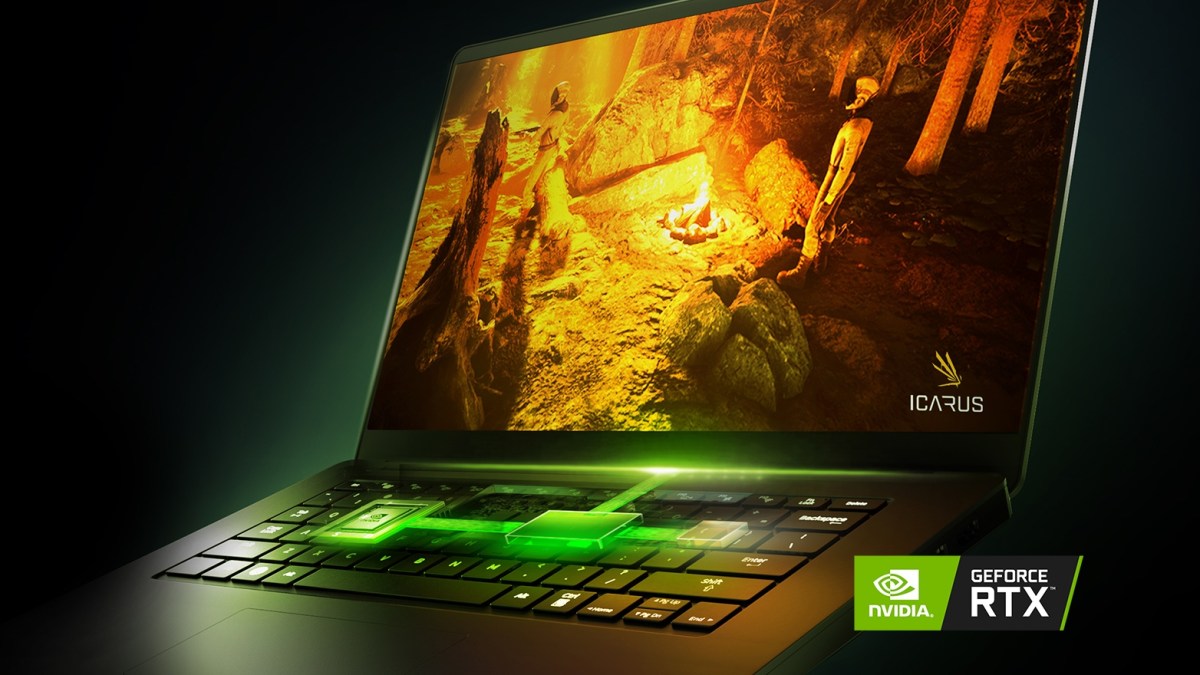How NVIDIA Advanced Optimus Makes Laptop Gaming Better Than Ever
NVIDIA’s clever Advanced Optimus tech gives your gaming laptop the best of all worlds, providing both strong gaming performance and impressive stamina.

This article is brought to you by NVIDIA.
With power-hungry, top-tier components, gaming laptops aren’t usually celebrated for their battery life. But NVIDIA’s latest portable computers tackle the problem head-on with some clever technology: Advanced Optimus.
To help get a better grounding in the tech, Den of Geek talked with NVIDIA’s Director of Product Management Vijay Sharma, whose work has touched all aspects of the company’s hardware from G-SYNC to GPUs.
The TL;DR of the tech is that it allows gaming laptops to automatically and intelligently switch between graphics outputs, giving you the best possible frame rate, the lowest possible input latency, and maximum battery life. But there’s a lot more to it than that.
How Does Advanced Optimus Work?
When it comes to Advanced Optimus, there are a lot of moving parts, Sharma explains, as it needs various panel makers, chip manufacturers, OEM developers, and laptop designers to all work together. “There’s a lot of players that have to dance to the music together to make this work,” he says.
To start with the basics, your gaming laptop comes with two GPUs: one basic unit, built into the processor for low-powered tasks like editing spreadsheets (the Integrated Graphics Processor, iGPU), and a high-powered one for heavy workloads, like pushing high frame rates in Fortnite, the discrete GPU, or dGPU for short. The dGPU is overkill for simple tasks like email and spreadsheets, and running the dGPU for light workloads would drain your battery for no reason since nobody cares about frame rate when you’re just checking emails, after all.
Now, in the bad old days of gaming laptops, you would have to physically switch between these two GPUs. Which is to say you’d have to reboot if you wanted to take a break from work to play a couple of rounds of Valorant, and you may even have had to fiddle with BIOS settings to make said switch.
This all changed with NVIDIA Optimus, the solution now known as MS Hybrid. NVIDIA found a way to detect if the computer has a graphically intense workload or not, and to automatically switch which GPU was active based on that workload. It was a clever optimization that guaranteed the user better battery life or extra performance.
But there was a catch with Optimus: the iGPU was typically hardwired to the laptop panel. This meant when rendering frames on the dGPU an additional step was necessary to get the image to the screen. This additional step comes with some time and computing costs.
While Optimus was still an improvement over manually rebooting to switch GPUs, the additional step increased latency and decreased framerate. In competitive games like Fortnite and Valorant, latency and framerate can be the difference between winning and losing a match. ,
How to keep latency low and framerates high while automatically switching between iGPU and dGPU? The solution is Advanced Optimus. Here, a hardware switch called a MUX is installed on the mainboard and connected to the laptop display. Combine this hardware switch with the same clever programming from NVIDIA, and you’ve got a system that automatically detects the intensity of a workload and automatically switches which GPU is connected to the display.
“We looked at a number of games, and with DOTA 2 you see a 27% improvement in frames per second versus MS Hybrid,” Sharma explains. “The FPS improvements with Advanced Optimus give you a sense of the FPS bottleneck. With Battlefield V FPS improvement was 20%, Wolfenstein it was 20%, Hitman 3 was 20%.”
Latency improvements are significant too. “The latency figures vary as well, depending on the game, on the order of 15-25%,” he says. This is, of course, better still when played with NVIDIA Reflex-enabled games. NVIDIA takes gaming and performance seriously, and Reflex is their suite of technologies designed to reduce latency and increase performance in order to deliver the best gaming experiences.
For Advanced Optimus, allowing a direct connection to the display also ensures support for advanced display technologies like NVIDIA G-SYNC, an intelligent technology that removes visual tearing and provides smooth framerates by syncing the display refresh rate to the same rate that the dGPU renders frames.
And, of course, there are the all-important battery gains. There shouldn’t be any difference between original MS-Hybrid and Advanced Optimus, Sharma tells me, but “versus a system where you are needing to reboot and set the MUX manually, you’ll get better battery life.”
Our Experiences with Advanced Optimus
After a grounding in the technology, I had to give it a go myself. Can I live the dream and use one laptop for work and play even if I forget to take the charger with me?
Using a laptop provided by NVIDIA — a Core i7, RTX 3080-toting beast that easily eclipses my own gaming desktop — I jumped into a mix of work and play, ignoring my natural instinct to return to the safety of the plug socket.
Obviously I started with “play.” I booted up Fortnite without the charger in reach. Thanks to NVIDIA’s clever software, graphical settings quickly adjusted, foregoing niceties such as ray tracing which I have on when plugged in, leaning on the clever DLSS tech to upscale to 2K, and sensibly capping my framerate to 60 FPS (though you can overrule this if you know that you’ll be at a charger soon).
Fortnite itself only occasionally dropped below that 60 FPS mark and still looked pretty splendid to my eyes. It was still working the NVIDIA Reflex technology that minimizes system latency to ensure I got the drop on my opponents, though I ultimately did pretty poorly over the course of two matches — you can’t win ‘em all.
After a solid 25-minute session, I decided it was time to do some actual work and give the hardware GPU a break. I found that I’d used around a third of the laptop’s 99WH battery for that, which is par for the course with gaming laptops going all out, and Windows wasn’t initially optimistic that I’d last much longer than 90 minutes more.
But despite that tantalizing prospect of knocking off work early for the day, it adapted and accepted that my less intense Google Docs usage is indeed less taxing on the battery than my middling Fortnite gunplay. I got the usual three-to-four hours of additional, more mundane use, while the RTX 3080 enjoyed a well-earned rest.
It’s worth noting that you can be more aggressive with the battery life savings if you choose. NVIDIA’s GeForce Experience software includes a suite of tools to give you more battery (and less fan volume if you’re playing in public) by automatically adjusting settings to reduce power consumption and optimize gameplay via clever AI maneuvering.
So what does the future hold for the tech? “I mean, there are always ideas,” Sharma says, noting that it all comes down to improving performance, reducing latency, and optimizing G-SYNC. “We want to continue on those three dimensions, delivering improvements, and continue expanding the footprint of Advanced Optimus laptops. We just want to get these features into the hands of more and more gamers.”
You can read more about NVIDIA Advanced Optimus here.
